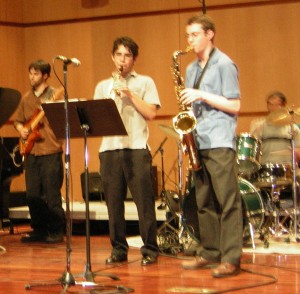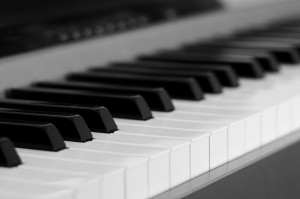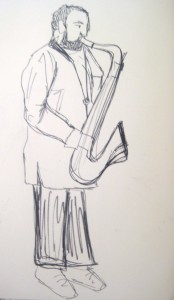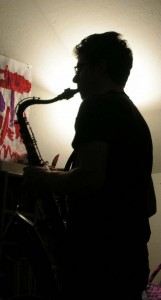Scott Hamilton & Harry Allen both on the tenor saxophone. My friend Alberto from Spain pointed me towards this one.
Olaf Polziehn on piano
Dave Green on bass
Steve Brown on drums
Scott Hamilton & Harry Allen both on the tenor saxophone. My friend Alberto from Spain pointed me towards this one.
Olaf Polziehn on piano
Dave Green on bass
Steve Brown on drums
By Neal 9 Comments
The pentatonic scales can be heard in music across the world. They have only five notes, but those notes seem to ‘fit’ well in a lot of places.
Learning pentatonic scales will enable you to quickly have something under your fingers that you can play. The blues scale and minor pentatonic scale are similar.
If you want to play pentatonic scales on tenor sax, to get from concert key (piano, guitar, etc) to Bb (the key that tenor and soprano sax are in) you need to go up a whole step.
So concert Bb is C on tenor sax, concert F is G on tenor sax, etc.
From there there,
The major pentatonic scale is the 1, 2, 3, 5, 6
In the key of C (on tenor sax) that would be C, D, E, G, A
Minor pentatonic scale is the 1, b3, 4, 5, b7
In the key of C (on tenor sax) that would be- C, Eb, F, G, Bb

If you never fail on saxophone…. you’re probably going to sound like crap.
Playing the same song every day without challenging yourself isn’t going to make you better. You also might be able to beat five-year-olds in basketball, but it doesn’t really mean you’re good.

If you casually lift light weights in they gym, you’re not going to get stronger either. Muscles grow if you push them to the edge.
You’ve probably seen that people progress in their careers following a failure. If you lose one job and get a much better one, it’s a step on the right track even if it didn’t feel good for the short term.
So don’t try to avoid failure!
Challenge yourself on saxophone!
Hello
I was concerned about what scales go with chords and if you have to play every chord you see in a tune.
Thanks
Donald

Neal:
You absolutely do not have to play every chord you see. If there’s a ii V I progression, those chords are in the same key, so you could just think of one key for all three of those chords.
Being able to hear the changes in what you play for a solo is cool and shows you know the song, but playing too many notes shows you don’t understand how to use space.
By Neal 9 Comments
If you’re somewhat new to saxophone, you want to learn all your major scales first. They will act as a foundation for you to relate many other scales in your mind.
Practicing them with a metronome, initially slowly, will help you master them.

Once you know the major scales, you have the basis to play all the modes as well.
Sometimes a few scales can go with a chord. All the modes work- ionion, dorian, phrygian, lydian, mixolydian, aeolian, and locrian work a little bit differently. Some are more useful than others, for instance you almost never use locrian.
Ionian is the same as the ‘major’ scale and can be played over major chords, mixolydian scales can be played over dominant seventh chords, a few of them are minor.
There are seven modes for each major scale. Each mode uses all the notes of that major scale, but they all start in different places.
The ionion mode starts on the root note of the major scale, the dorian mode starts on the second note, phyrigian starts on the third note etc.
Because they start in different places, they have different intervals between the notes and therefore have a unique sound.
Major 1 2 3 4 5 6 7 8
Dorian 1 2 b3 4 5 6 b7 8
Phrygian 1 b2 b3 4 5 b6 b7 8
Lydian mode – 1 2 3 #4 5 6 7 8
Mixolydian mode – 1 2 3 4 5 6 b7 8
Aeolian mode – 1 2 b3 4 5 b6 b7 8
Locrian mode – 1 b2 b3 4 b5 b6 b7 8
If you construct scales based off of these chords, they are as follows
For use with the triad, 7th, 9th, 11th, 13th chords-
Ionian: Maj Maj7 Maj9 Maj11 Maj13
Dorian: min min7 min9 min11 min13
Phrygian: min min7 min7(b9) min11(b9) min11(b9b13)
Lydian: Maj Maj7 Maj9 Maj7(#11) Maj13(#11)
Mixolydian: Maj 7 9 11 13
Aeolian: min min7 min9 min11 min11(b13)
Locrian) dim min7(b5) min7(b5b9) min11(b5b9) min11(b5b9b13
Found this sketch of a sax player the other day by Regina Agu.
Made me think of the sax players I see on the street. In Heidelberg, I saw a few alto sax players on the same main street as I was walking along.
My friend David would sometimes tell me that I was definitely better than the sax players outside the baseball stadiums. Although that wasn’t saying too too much!

By Neal 3 Comments
“Furthermore, one must *get out of one’s own way*, so to speak. People waste a lot of energy on their embouchure and cause themselves more problems than they need to have. All the strength you need for your embouchure is already there; it is the sensitivity and awareness that must be developed.”
-Richard Tabnik (from his lessons with Joe Allard 9/79 to 6/83)

After playing for a while, that lesson really makes sense.
I used to hurt my bottom lip playing too long, probably because it was too tense.
Now my embouchure on saxophone is more relaxed and I find I can play for much longer.
Unspoken Language-they play Dizzy Gillespie’s “Birk’s Works” with an alto sax solo before the group joins in.
“Unspoken Language” is the first in a series of films about jazz.
Al McLean on saxophone
Kevin Dean on trumpet
Morgan Moore on bass
Hans Verhoeven on drums
“I felt it was a great way for the listener to gain insight into the music, to see and hear it performed on period instruments,” says Randy Cole, the film’s director. “I asked them to play a variety of vintage horns during this session. It took them slightly outside of their comfort zone, and brought some unpredictability and freshness to the performance.”
There seem to be a number of sax players in London that frequent Sax Station, so I did a little bit of investigation with the help of Andre Emond.
A few prominent saxophone players in London include Gilad Atzmon,Tommaso Starace, Matt Wates, Paul Booth, Dave Ohiggins, Mornington Lockett, Christian Brewer, and Derek Nash.
“The jazz scene is not bad but does not pay a lot,” according to Andre Emond.
Once upon a time, there was jazz at the royal Festival Hall in the foyer in London.

Andre also helps run jazz sessions at the cafe in the local library in Croydon- every Thursday at lunchtime and it has been running for about 9 years
Derek Nash does loads of work but travels all over the place
The harmonic structure of a song sometimes seems to restrict you.
If you play a certain note against a certain chord, they will clash.
However, having a strucure forces you to work with it in creative ways.

If you’re watching a sports match, the players follow rules.
It wouldn’t be interesting if they got into the stadium or court and just did whatever they wanted.
Some poems, for example, the haiku have a very specific structure too.
And the haiku can be beautiful.
The structure helps set up a groove in music and lends itself to creating patterns that are related.


Want to play saxophone, but feeling lost and not sure how to get started?
In this online/downloadable class you will see methodical lessons in a sequence and you can get feedback and ask questions at any point.
Learn more
Want to take your playing to the next level?
You’ll learn fundamental saxophone skills, building past the basics. Master rhythms. Learn about phrasing, tone, and more. Here you will get feedback which is crucial to developing good habits.
Learn more